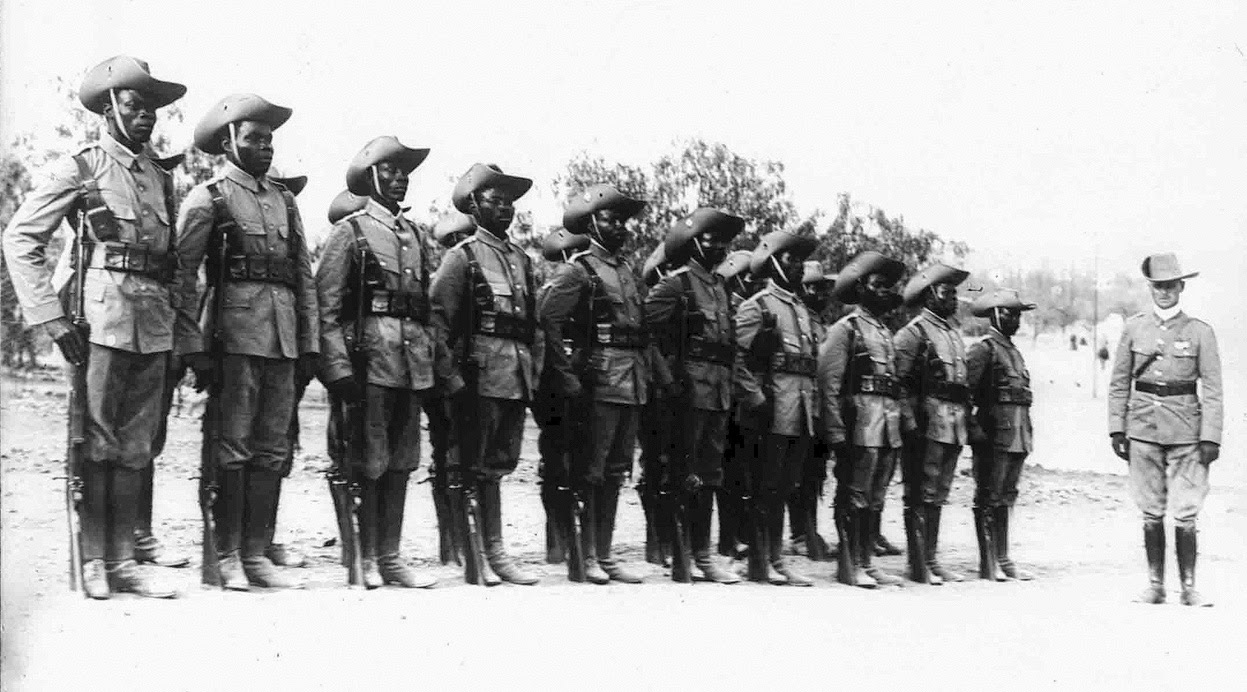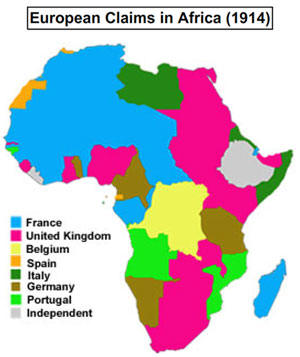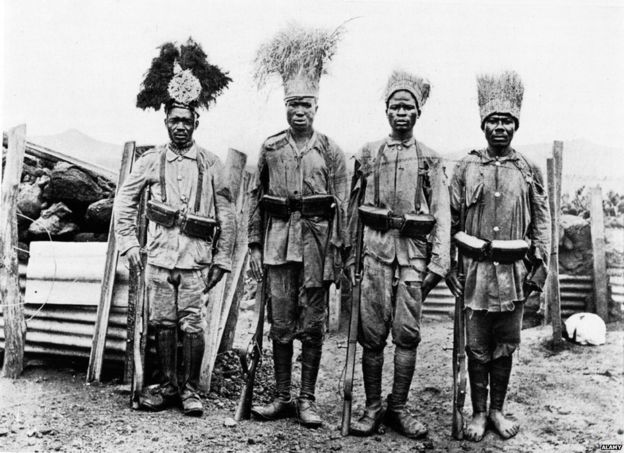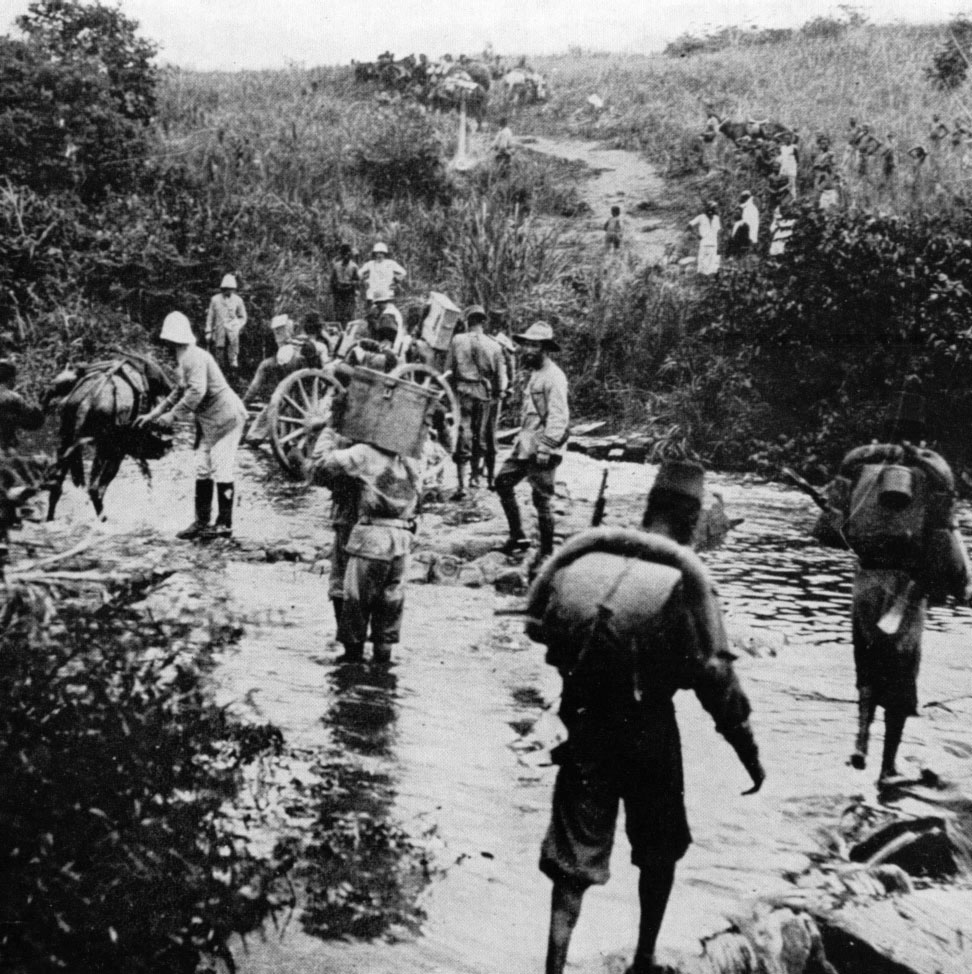Millions of Africans Pressed into Servitude;
Disease, Exhaustion Take Their Terrible Toll
Special to The Great War Project
(20-23 August) Africa is also a front in the First World War: an enormous battleground stretching across the continent.
For years, Europe’s great powers are busy carving up Africa into colonial territories. Britain has widespread African colonies. France as well, and Germany. Belgium has the Congo.
Now each European power covets the colonies that their enemies control.

Cameroon company in fight for Africa, date and place uncertain.
“Africa provided Britain, France, and Germany with manpower,” writes historian Michael Neiberg. “The Allies had the advantages of more populous colonies, more wealth in Africa itself, and a favorable geographic position.”
“War in Africa led to high casualty levels not only from direct combat, but also from disease and exhaustion in the unforgiving climate. Casualty rates among human porters,” reports Neiberg, “were especially high.”
Writes historian Adam Hochschild, “Small contingents of British, South African, French and Belgian troops, with far larger numbers of African conscripts, had fought German soldiers (with their own conscripts) everywhere from Cameroon [in central Africa] on the west coast of the continent to German Southwest Africa [now Namibia] to Tanganyika [also known as German East Africa, now Tanzania].”

The European scramble for Africa.
Hochschild reports: “Just as Germany openly coveted the central African colonies of France and Belgium, which would give Berlin an unbroken belt of territory stretching across the continent, so the Allies were maneuvering to seize Germany’s African possessions.”
In the process all the warring colonial powers used forced labor to carry out and support their attacks.
No warring power has clean hands, neither Germany nor Britain and France.
“Like the Germans,” writes Hochschild, “they had for decades used forced labor in their African colonies. But now the number of such laborers swelled and their working conditions grew unbearably hard as both sides conscripted huge numbers of African porters to carry military supplies long distances through terrain that lacked roads for vehicles.”

African troops in German East Africa, date uncertain.
The treatment of these African conscripts by all the colonial powers is nothing less than criminal.
The deaths that these Africans suffer are not deemed worthy of being accurately counted.
They are underfed African porters, reports Hochschild, “subjected to whippings as punishment, who for years carried wounded men or sixty-pound loads of food and ammunition through rain forest, swampland, and savanna.”
As the battles swung back and forth, “some who had been forced to work for one side found themselves carrying supplies for the other.”
Estimates are that more than two million Africans were pressed into servitude. Some 400,000 are believed to have died “mostly of disease or exhaustion, a death rate far higher than that for British troops on the Western Front.”
And that does not tell the whole story.

Belgian porters in east Africa.
Hochschild writes, “With African farmers conscripted as porters and rival armies seizing villagers’ grain and cattle, famine spread. Many African women and children were reduced to eating roots and grass before they starved.”
“Their deaths went untabulated, but low estimates put them in the hundreds of thousands.”
Africa would not recover from this devastation to its population for decades.

Mike, thanks so much for including the map of Africa with this post… incredible. I can’t think of anything else to add, it’s just incredible what was once acceptable.
Morocco was a French – Spanish protectorade. Guinea Ecuatorial (formerly Spanish Guinea) does not appear in the map. It was a Spanish colony that played a small but important role in the development of the African war theatre. German troops from Cameroon crossed the border and took refugee from the French colonial troops in 1915.
Mike: If you did not see it yet the book On Call in Africa by Norman Jewell includes eyewitness accounts and 145 original photographs largely from the WW1 East Africa period. Norman Jewell was in charge of medical support for the forces as they moved out of Kenya and through Tanzania. Please see the website http://www.oncallinafrica.com for more details. 200 original photos are also now in the Mary Evans Photo Library. All helps build awareness! @gillyflower_pbl on twitter, http://www.fb.com/oncallinafrica in addition to the above main book website. Richard Jewell